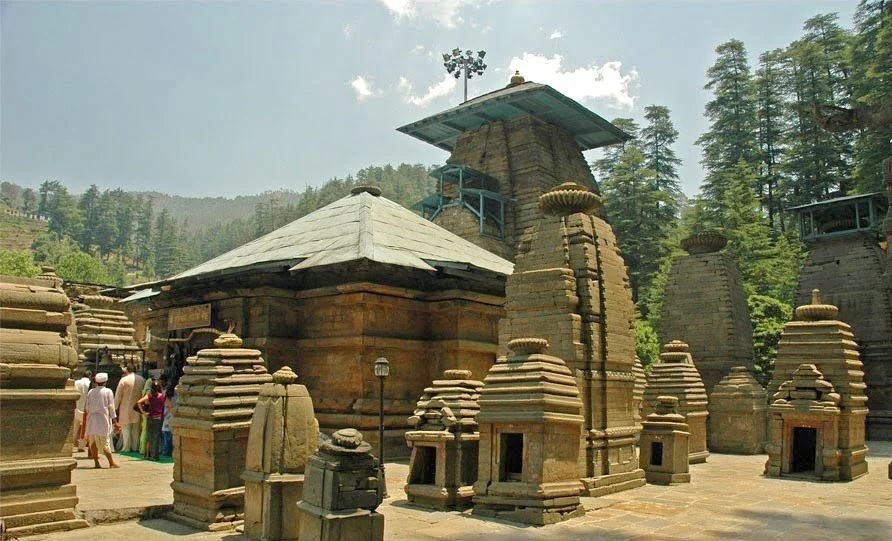There are places in the Himalayas where time seems to stand still, and the Jageshwar Temple Complex is one of them. Nestled in a quiet valley surrounded by tall deodar trees, this ancient cluster of stone shrines feels less like a monument and more like a living, breathing spiritual landscape. The moment you step into the complex, the air thickens with the fragrance of incense and pine, and you realize you’ve entered a world where history, mythology, and devotion have been flowing together for centuries.
I had heard about Jageshwar before, mostly as a hidden gem in the Kumaon region, but nothing quite prepared me for the experience. This isn’t just one temple—it’s a complex of over 100 small and large stone temples, dating back to the 7th–12th centuries. Each shrine carries its own identity, yet together they create a powerful energy that makes you want to linger, listen, and reflect.
The Setting: A Forest of Deodars and Stories
Jageshwar is located about 36 kilometers from Almora, tucked into a narrow valley flanked by rolling hills and dense deodar forests. The drive itself is enchanting—winding roads lined with towering evergreens, villages scattered on slopes, and the occasional glimpse of a gurgling stream below.
The temple complex stands right at the heart of this valley, almost as if the gods deliberately chose this serene spot to rest. The silence of the place is striking. You hear the wind rustling through the tall trees, the call of distant birds, and the soft ringing of temple bells blending with the murmur of a nearby stream.
For centuries, pilgrims and travelers have walked this same path. Some came seeking blessings from Lord Shiva, while others came as scholars and artisans who added their mark to the architecture. Even today, locals believe that Jageshwar is one of the sacred Jyotirlinga sites mentioned in Hindu scriptures, though historians debate whether it was officially part of the 12 Jyotirlingas.
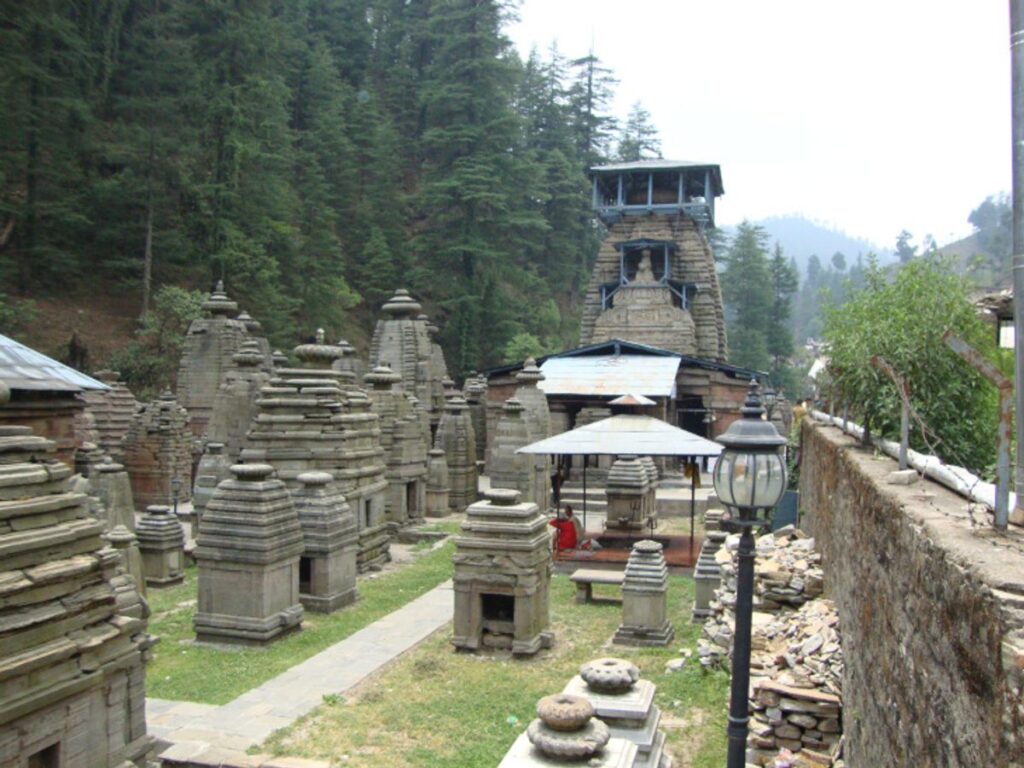
Architecture That Speaks of Time
Walking into the complex feels like stepping back a thousand years. Stone temples—small, medium, and large—stand shoulder to shoulder in rows, creating a miniature city of shrines. Historians say the temples were built mostly between the 7th and 12th centuries, under the Katyuri and later Chand rulers.
- Main Shrine of Jageshwar Mahadev: The central temple is dedicated to Lord Shiva, worshipped here as Jageshwar or the Lord of the Ages. The Shiva lingam in the sanctum is constantly bathed in ritual offerings of water, milk, and flowers.
- Dandeshwar Temple: Slightly apart from the main complex, this is one of the largest temples in the group. Its tall shikhara (spire) towers over the smaller shrines around it.
- Kuber Temple: Dedicated to the god of wealth, this temple is often missed but holds intricate carvings worth pausing to admire.
- Chandika and Nav Durga Temples: Reflect the strong presence of Shakti worship in the region.
The style of the temples is distinctly Nagara (North Indian), with curving spires, carved doorframes, and delicate stonework. Some carvings depict deities, while others show dancers, animals, and mythological motifs. Even though many temples are weathered by time, the craftsmanship still radiates elegance.
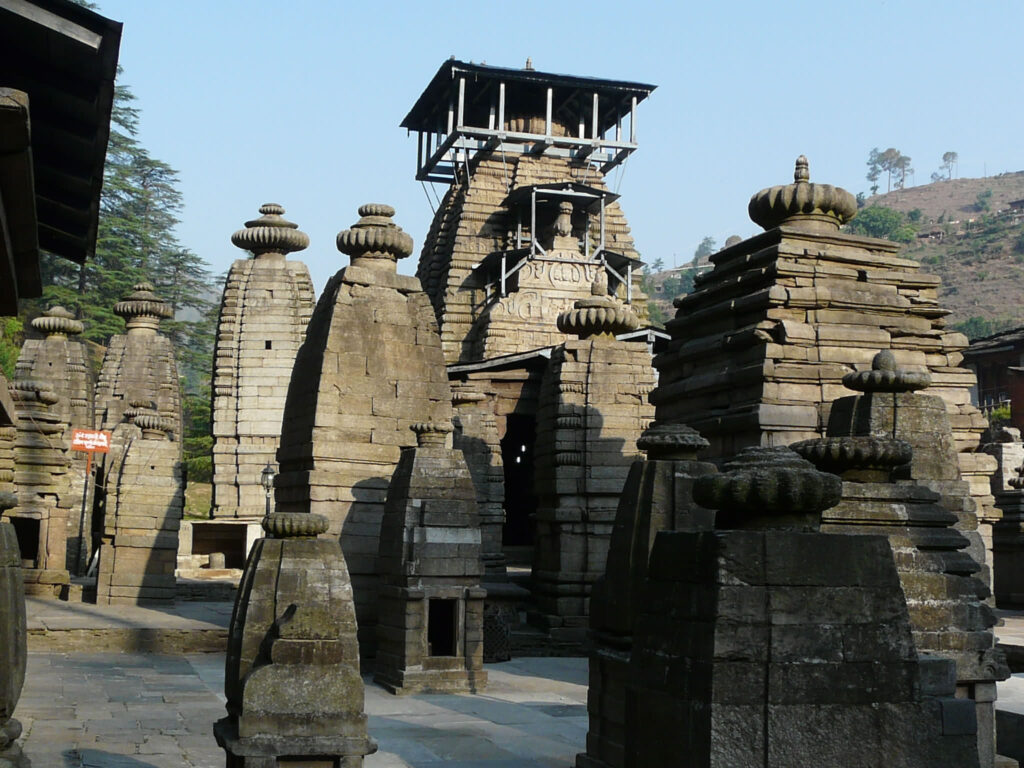
Legends and Spiritual Significance
No temple in India is complete without its stories, and Jageshwar has plenty.
- The Jyotirlinga Connection: Some ancient texts claim that Jageshwar was once revered as the eighth Jyotirlinga, though this is debated among scholars. Pilgrims still consider it immensely sacred, especially as a place where Shiva is believed to meditate in his “child form.”
- Adi Shankaracharya’s Visit: Local traditions say that Adi Shankaracharya, the great philosopher, visited Jageshwar to revive the Shaivite tradition and purify the temples from neglect.
- The Eternal Flame: In many temples here, devotees light diyas (oil lamps), believing the flame carries prayers directly to Lord Shiva.
Even if you don’t dive deep into the legends, the spiritual charge of the place is undeniable. Sitting quietly near the sanctum or under the shade of a deodar tree, you feel an energy that words can hardly capture.
Experiencing the Temple Complex
One of the joys of visiting Jageshwar is that it doesn’t feel like a rushed tourist site. You can move at your own pace.
- Mornings: The air is cool, the temple bells echo gently, and priests perform the morning aarti with fresh flowers and incense. It’s the best time for quiet meditation.
- Afternoons: Sunlight filters through the deodar canopy, casting shifting patterns of light on the stone shrines. Photographers often love this time.
- Evenings: The aarti in the main shrine brings the entire complex alive. The glow of oil lamps against the grey stone walls feels otherworldly.
Unlike big city temples, rituals here are intimate. Devotees often bring simple offerings—milk, flowers, or a packet of prasad from nearby shops. You can sit cross-legged near the lingam, watch the priests chant, and let the rhythm carry you into calmness.
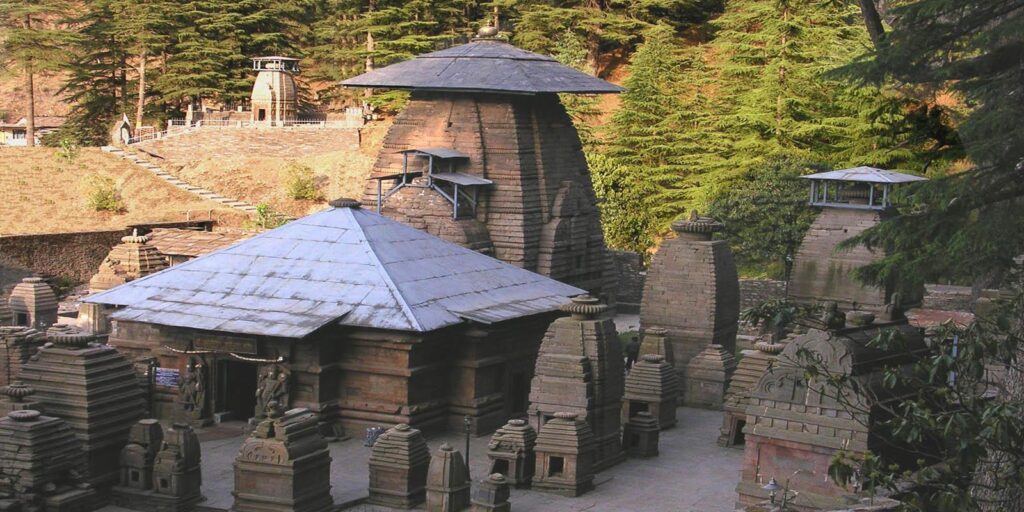
Treks and Nature Walks Around Jageshwar Temple Complex
While the Jageshwar Temple Complex itself is a treasure trove of history and devotion, the experience doesn’t end at the stone shrines. The surrounding landscape of Kumaon is a walker’s paradise. Gentle forest trails, hillside treks, and hidden paths through villages make this destination perfect for those who want to combine spirituality with nature.
I found that walking around Jageshwar is as rewarding as the darshan inside the sanctum. The quiet trails through deodar, pine, and rhododendron forests offer a chance to breathe deeply, reflect, and truly connect with the environment. If you love the idea of slow exploration, here are some must-try treks and walks near Jageshwar.
1. Jageshwar to Dandeshwar Temple Trail
This is probably the easiest and most popular walk around the temple complex. The Dandeshwar Temple, about 1.5 km away, is considered part of the same spiritual landscape as Jageshwar. The walk takes you through shaded forest paths, where the sound of birdsong replaces the hum of vehicles.
- Distance: ~1.5 km one way
- Time: 30–40 minutes at a leisurely pace
- Highlights: Tall deodar trees, moss-covered stones, and the sight of the impressive Dandeshwar Temple spire rising out of the forest canopy.
It’s short but magical—perfect for first-timers who want to ease into the rhythm of Kumaon walks.

2. Jageshwar to Vriddha Jageshwar
If you’re looking for a slightly longer trek with rewarding views, head uphill to Vriddha Jageshwar, located about 8 km from the main complex. This temple represents Shiva in his “old” or “sage” form, and the climb feels symbolic—like walking toward wisdom.
- Distance: 8 km uphill
- Time: 3–4 hours depending on pace
- Trail: A combination of forest paths and stone-paved routes through small hamlets
- Highlights: Panoramic views of the valley, glimpses of traditional Kumaoni village life, and the serene temple at the top.
From the summit, the temple overlooks the entire Jataganga valley, with the spires of Jageshwar barely visible through the trees. It’s one of those treks that blend spirituality and physical endurance beautifully.
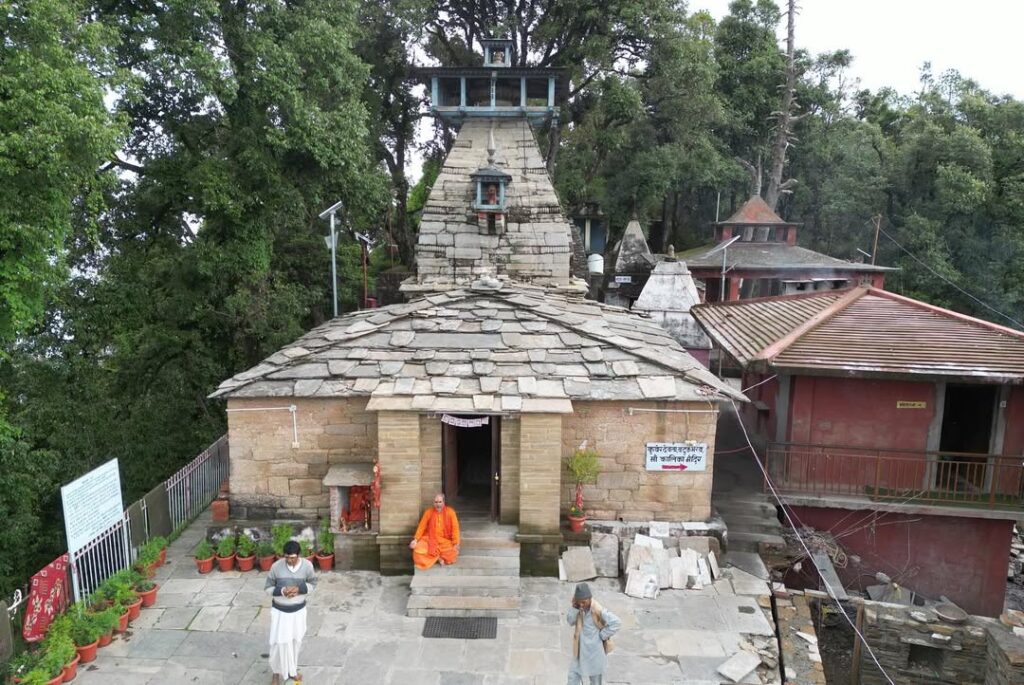
3. Forest Walks Around Jageshwar
Not all walks here have to be destination-focused. The deodar forests themselves are an attraction. You can spend hours wandering the soft forest floor, surrounded by trees that are hundreds of years old. Locals believe these groves are sacred, and when you walk among them, it’s easy to see why.
- Best Time: Early morning, when the forest is wrapped in mist, or late afternoon when sunlight filters through the tall trunks.
- What to Expect: Tranquility, bird calls, wildflowers, and the soothing sound of streams.
Carry a book or a journal, and you’ll find plenty of spots where you can just sit under a tree and write, meditate, or simply listen.
4. Trek to Binsar Wildlife Sanctuary
For adventure lovers, combining Jageshwar with a visit to Binsar Wildlife Sanctuary is a fantastic idea. While it’s about 25 km away by road, there are connecting trails that locals sometimes use. The sanctuary is known for its biodiversity—leopards, barking deer, Himalayan black bears, and over 200 species of birds.
- Distance: ~20–25 km depending on the trail taken
- Time: A full-day trek (or 2 days with a night halt)
- Highlights: The iconic Zero Point, which offers jaw-dropping views of Nanda Devi, Trishul, and Panchachuli peaks.
This trek is for those who want to extend their Jageshwar trip into a Himalayan adventure.
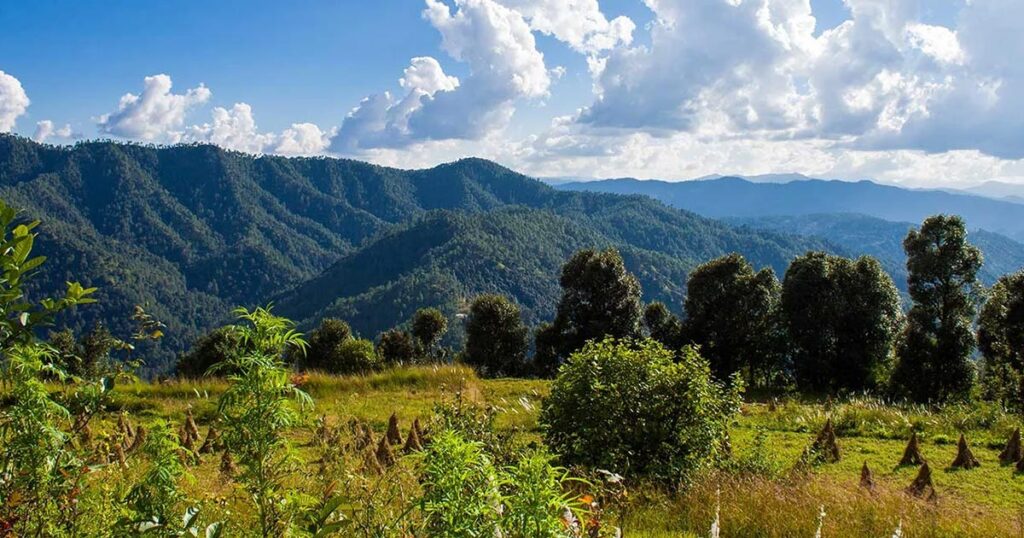
5. Village Walks Around Jageshwar
Sometimes the best walks are the simplest ones. The small villages surrounding Jageshwar, with their slate-roofed houses, terraced fields, and friendly locals, are worth exploring.
- Activities: Chat with villagers about farming practices, watch women weaving wool, or taste fresh buttermilk offered by hospitable families.
- Why It’s Special: It gives you an authentic glimpse of Kumaoni life that no guidebook can fully capture.
The combination of spirituality at the temple and the simplicity of village life creates a wholesome travel experience.
6. Meditation Walks Along the Jataganga Stream
The Jataganga stream, which flows past the temple complex, is another beautiful trail. You can follow its course for a few kilometers, listening to the water gurgle over rocks and occasionally stopping to dip your feet in the cool water.
- Best For: Solo travelers or couples looking for quiet reflection
- Highlights: Small stone bridges, hidden shrines, and the play of light on water
This walk feels less like a trek and more like a gentle spiritual journey with nature as your guide.
Festivals at Jageshwar
The temple complex comes alive during annual festivals, drawing pilgrims from across Kumaon and beyond.
- Maha Shivaratri: The biggest celebration, when devotees throng to offer prayers to Lord Shiva. The night-long vigil, bhajans, and rituals create an electric yet serene atmosphere.
- Jageshwar Monsoon Festival (July–August): A local celebration when the valley turns lush and villagers gather for community prayers, music, and feasts.
- Annual Jageshwar Festival: Celebrates both Shiva and Shakti, with cultural performances and fairs around the temples.
If you happen to visit during these times, prepare for crowds, but also for an unforgettable spiritual experience.
Best Time to Visit Jageshwar Temple Complex – A Season-by-Season Guide
One of the things I love about the Jageshwar Temple Complex is that it feels different with every season. The ancient stone shrines, the towering deodars, and the gentle mountain streams all respond to the changing moods of nature. Depending on when you visit, Jageshwar can be serene and meditative, lush and alive, crisp and festive, or wrapped in the stillness of snow.
If you’re planning a trip, here’s a detailed look at what each season brings to this Himalayan valley.
Spring (March to April): A Gentle Awakening
Spring in Jageshwar is like a soft breath of fresh air after the cold winter. The valley comes alive with new leaves, wildflowers bloom along the trails, and the deodar forest looks greener than ever.
- Weather: Pleasant, with daytime temperatures between 15–25°C. Evenings are cool but not biting.
- Experience: The temples glow under clear skies, and mornings are crisp—perfect for exploring the complex slowly. You’ll find fewer crowds, which means plenty of quiet moments for meditation or photography.
- Activities: Forest walks to Dandeshwar, light treks to Vriddha Jageshwar, or just sitting by the Jataganga stream.
- Why Visit in Spring?: It’s the season of renewal, so the atmosphere feels uplifting. Pilgrims and casual travelers alike can enjoy the temples without rush or heavy clothing.
Summer (May to June): Comfortable and Festive
Unlike the scorching plains of India, summers in Jageshwar are mild and comfortable. This is the time when pilgrims begin arriving in larger numbers, and the valley feels lively but not overwhelming.
- Weather: Warm but pleasant, with daytime temperatures between 20–30°C. Nights are cooler, around 12–15°C.
- Experience: The temple courtyards are filled with the sound of bells and chants. The evenings often host small rituals and lamps that make the complex glow beautifully.
- Activities: Great for longer treks—like the 8 km hike to Vriddha Jageshwar or day trips to Binsar Wildlife Sanctuary. Birdwatchers especially love this season, as migratory species often make appearances.
- Why Visit in Summer?: It’s the easiest season for travel—roads are clear, weather is kind, and everything is accessible. If you want to combine Jageshwar with Almora or Binsar, this is the perfect window.
Monsoon (July to September): Lush but Tricky
Monsoon transforms Jageshwar into a mystical green paradise. The forested valley becomes lush, waterfalls come alive, and mist often wraps the temples in an almost dreamlike shroud. But the rains also bring challenges.
- Weather: Heavy rainfall with temperatures around 15–22°C. Humidity can be high, and sudden showers are common.
- Experience: The temples look magical in the mist, and the stone spires glisten in the rain. It feels deeply spiritual, but it can also be impractical for travelers not used to wet conditions.
- Activities: Short walks around the temple complex, photography in the mist, and attending the Jageshwar Monsoon Festival, which draws locals and pilgrims.
- Caution: Landslides and slippery trails can make travel risky. Always check weather updates and avoid long treks during this season.
- Why Visit in Monsoon?: If you’re a romantic traveler or photographer who loves dramatic landscapes, this is your season. But it’s not ideal for first-time visitors or families.
Autumn (October to November): Clear Skies and Festivals
Autumn is perhaps the best time to visit Jageshwar. The rains wash the valley clean, the skies turn a crisp blue, and the views of the hills are unbeatable. The festive spirit also adds a unique charm.
- Weather: Comfortable, with daytime temperatures between 12–20°C and cooler nights.
- Experience: The temples are bathed in golden sunlight during the day and lamp-lit in the evenings. Crowds pick up around festivals, but the energy is infectious rather than overwhelming.
- Activities: Trekking is at its best—clear trails, dry weather, and stunning views. Autumn is also festival season across India, so you’ll often find local fairs or special rituals taking place.
- Why Visit in Autumn?: It combines the best of all worlds—pleasant weather, clear skies, and vibrant cultural energy. Many seasoned travelers consider this the ideal time for Jageshwar.
Winter (December to February): Quiet and Snow-Kissed
Winters at Jageshwar are a different experience altogether. The valley slows down, the deodars stand tall against frosty air, and occasional snowfall turns the temples into a fairy-tale scene.
- Weather: Cold, with daytime temperatures between 5–12°C and nights dropping close to 0°C. Snowfall is occasional but possible.
- Experience: The complex is quieter, with fewer visitors. You’ll often have large sections of the temple cluster almost to yourself. If you’re lucky, you may witness the stone shrines dusted with snow—a surreal sight.
- Activities: Perfect for meditation, writing, photography, and cozy walks through silent forests. Treks are limited due to icy paths, but short walks are doable.
- Why Visit in Winter?: For solitude seekers and spiritual travelers, winter is magical. The silence of the valley and the crisp air make the experience unforgettable.
So, When Should You Go?
- For Spiritual Quietude: Spring or Winter
- For Easy Travel and Longer Treks: Summer
- For Photographers and Nature Lovers: Monsoon (with caution)
- For Festivals and Clear Views: Autumn
If I had to choose just one, I’d say October–November hits the sweet spot—it’s comfortable, vibrant, and culturally rich. But honestly, Jageshwar has something unique to offer in every season.
Practical Travel Tips
- Best Time to Visit: March–June and September–November. Winters can be chilly, and the monsoon roads may get slippery.
- Getting There: Jageshwar is about 36 km from Almora. The nearest railway station is Kathgodam (125 km), and the nearest airport is Pantnagar.
- Stay Options: Almora has charming guesthouses and resorts, while Jageshwar itself offers basic lodges and dharamshalas for pilgrims.
- What to Carry: Comfortable walking shoes, light woolens even in summer, and some cash (as digital payments aren’t always reliable).
Why Jageshwar Stays With You
What struck me most about Jageshwar wasn’t just its scale or history—it was the silence of devotion. Unlike many pilgrimage spots that feel commercialized, Jageshwar still retains a raw, untouched essence. Locals, priests, and visitors interact with genuine warmth. There’s no rush, no overwhelming noise—just a quiet flow of people seeking something higher.
If you’re a history buff, the temples will fascinate you with their stonework and inscriptions. If you’re spiritually inclined, the energy here will give you a sense of grounding. And if you’re simply a traveler who loves discovering hidden corners of India, Jageshwar offers that rare blend of beauty, serenity, and storytelling.
FAQs
Q1. Where is Jageshwar Temple Complex located?
It is located about 36 km from Almora town in Uttarakhand, amid dense deodar forests.
Q2. How many temples are in the Jageshwar complex?
There are around 124 stone temples, mostly dedicated to Lord Shiva.
Q3. What is the historical significance of Jageshwar?
The temples date back to the 7th–14th centuries, showcasing Katyuri and Chand dynasty architecture.
Q4. Which is the main temple here?
The Jageshwar Mahadev Temple, dedicated to Lord Shiva as the ruler of Nagas (serpents).
Q5. Why is Jageshwar called a Jyotirlinga?
It is believed by many to be the site of the 8th Jyotirlinga of Lord Shiva.
Q6. What is unique about the architecture?
The temples feature intricate stone carvings, tall shikharas, and ancient idols.
Q7. What festivals are celebrated here?
Maha Shivaratri and Jageshwar Monsoon Festival are celebrated with great devotion.
Q8. How can one reach Jageshwar Temple?
It is accessible by road from Almora, Kathgodam, and Haldwani; nearest railhead is Kathgodam.
Q9. What is the best time to visit Jageshwar?
March to June and September to November are ideal for pleasant weather.
Q10. Is there an entry fee?
No, entry is free, though Archaeological Survey of India (ASI) maintains the complex.

